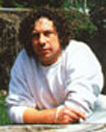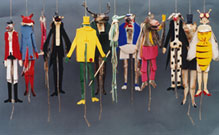History
One of the oldest regions for wooden toys is Oberammergau, well known because of its passion plays. The origin of the art of woodcarving in Oberammergau may well go back to the 15th century. Here, as elsewhere in regions where peasants lived, early on most carved objects were probably intended for utilitarian purposes.
|  Markus Wagner | ||||
 It is not known at what point in time the carving of wooden toys began. It was economic necessity which forced the local population to take on this sideline in order to support themselves. While in the beginning this avocation was practiced only in the evenings or during the long winter months, eventually it became the main occupation which involved the whole family. In the course of the 18th and 19th centuries in the workshops of small family enterprises there evolved the wooden toys which soon reached the all important markets of St. Petersburg, Kopenhagen, Gothenburg, and Drontheim among others. The Oberammergauers were able to remain relatively independent of outside merchants since many took their carvings on packboards to all parts of Europe. For them not only sacred carvings, but secular wood sculpture was equally important. Most of the producton of these latter carvings went into making Jumping Jacks, considered typical for Oberammergau. The Oberammergau Jumping Jack was a creation of this area and became famous throughout the world. Among the townspeople, the Jumping Jack as a carricature of disliked people, became a fashion between 1750 and 1850. The strong competition from other toy manufacturers, especially tin toys, contributed to a decline in the production of wooden toys. Since approximately 1880 wooden toys like these were no longer carved and can only be seen in museums and private collections.  A hundred years later, in the early eighties, our interests in local history and sculpture led us to many visits of the Oberammergau museum with its extensive collection of early works. In contrast to the ever more developed art of woodcarving, including machine made products, we were especially taken by the simplicity of these early works. Over a prolonged period of time, experimentation with techniques, materials, tools and experience gained, as well as the endorsement of this product as shown by the demand for it, led to the formation of aworkshop community. Here there is an ideal division of labor for the diverse specialization associated with the old time method of production. Thus, we strive to combine the charming appeal of handcraft and the natural materials with the pleasure that comes from an unending repertoire of contemporary Jumping Jacks, whose shapes, as in early centures are finding admirers throughout the world.
| |||||











